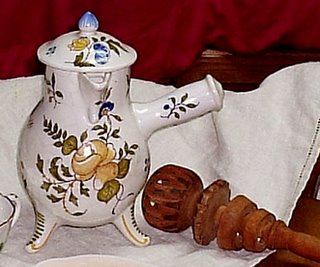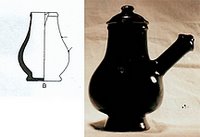 Ordinarily one chocolate tablet [my recipe for chocolate tablets] is used to a (four-ounce) cup, but the proportion is ten cups to the pound; so take as many tablets as you wish cups; melt the plain (unsweetened) chocolate in a coffeepot in which you have put water to the amount that you want to make; boil it and let it simmer a little over hot coals; when it is melted . . . mix the yolk of an egg with some (previously prepared) chocolate and put it in your coffeepot. Put it back over a gentle fire and stir well with the chocolate stick. It must not be allowed to boil at all after you have put the egg yolk in; the number of egg yolks nust be in proportion to the number of cups you make. You need one for four or five cups."
Ordinarily one chocolate tablet [my recipe for chocolate tablets] is used to a (four-ounce) cup, but the proportion is ten cups to the pound; so take as many tablets as you wish cups; melt the plain (unsweetened) chocolate in a coffeepot in which you have put water to the amount that you want to make; boil it and let it simmer a little over hot coals; when it is melted . . . mix the yolk of an egg with some (previously prepared) chocolate and put it in your coffeepot. Put it back over a gentle fire and stir well with the chocolate stick. It must not be allowed to boil at all after you have put the egg yolk in; the number of egg yolks nust be in proportion to the number of cups you make. You need one for four or five cups."Another recipe for hot chocolate, this time the way it would have been prepared in Mexico before coming to Europe. The addition of chilis would make it even more authentic.
The following is my paraphrased summary of chocolate pots from thesis: Blanchette, Jean-Francois (Ph.D.: Anthropology, 1979, Brown University) Title: The role of artifacts in the study of foodways in New France, 1720-1760 : two case studies based on the analysis of ceramic artifacts.
"The chocolate pot [displayed with French Moulinets] is a pouring pot with a bulbous body and a horizontal handle. In 1690 Furetière described a chocolate pot as follows:
 • “a coquemart-silver or copper vessel in which chocolate is mixed with a twirl and cooked. Savary des Bruslons (1759) described the chocolate pot as follows:
• “a coquemart-silver or copper vessel in which chocolate is mixed with a twirl and cooked. Savary des Bruslons (1759) described the chocolate pot as follows: • “A type of pot, or coquemart with handle, and lid with holes in the centre, in which chocolate is melted and cooked. Most of the chocolate pots were copper; and others, silver.
Diderot does not mention the chocolate pot. However, the Supplement to the Encyclopédie in 1776-77 describes the chocolate pot as follows:
•CHOCOLATE POT, (Domestic Economy),type of pot used for preparing the liquid food known as chocolate. Chocolate pots are made of silver, tin-plated copper, tin and earthenware. The latter are unsuitable, because once they are heated they continue to boil for a long time, which tends to evaporate the most exquisite flavour in the chocolate. Silver or copper ones have the disadvantages of being rounded at the bottom and a large quantity of the chocolate is not touched by the twirl. A truncated cone shape is the ideal shape for a chocolate pot. … The lid of the chocolate pot is pierced in the centre to give access to the handle of the twirl (the French style is called a moulinet).
 This text is more detailed than the previous ones. Its author was somewhat confused, however, about the shape of the chocolate pot [and moulinets], which was sometimes bulb-shaped, sometimes in the shape of the truncated cone similar to the brown faïence coffeepot which Diderot illustrates in 1765."
This text is more detailed than the previous ones. Its author was somewhat confused, however, about the shape of the chocolate pot [and moulinets], which was sometimes bulb-shaped, sometimes in the shape of the truncated cone similar to the brown faïence coffeepot which Diderot illustrates in 1765."Michel Nichol's reproduction 18thC pottery.

No comments:
Post a Comment